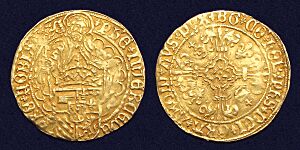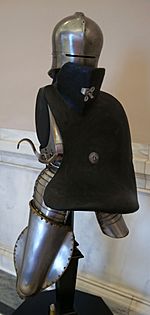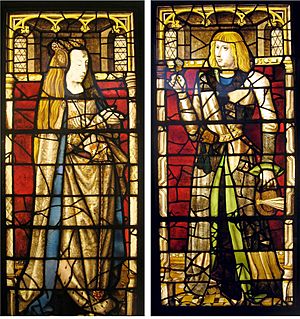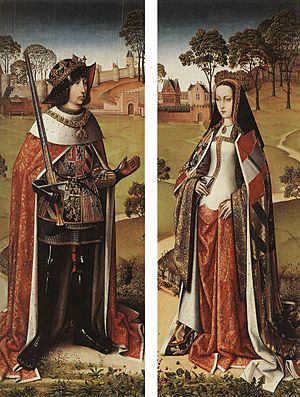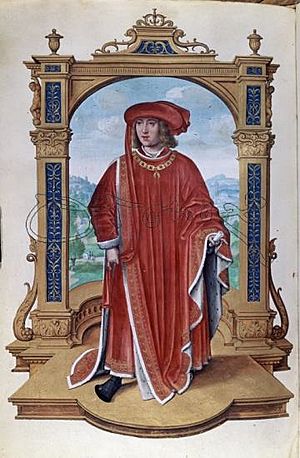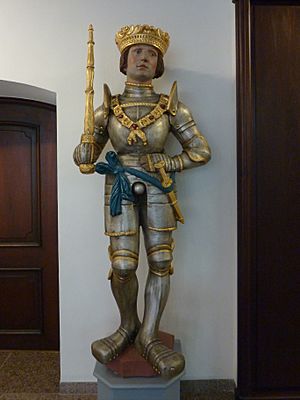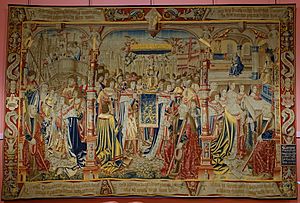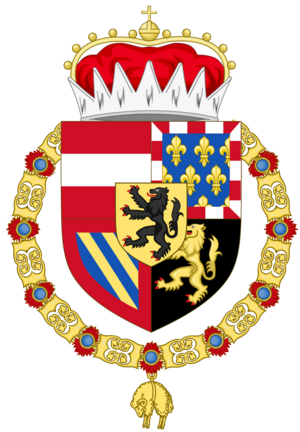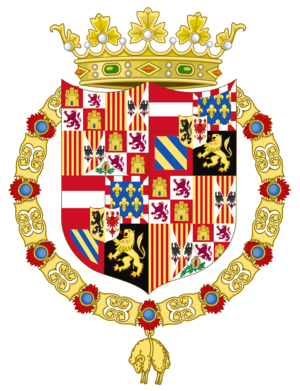Philip I of Castile facts for kids
Quick facts for kids Philip the Handsome |
|
|---|---|
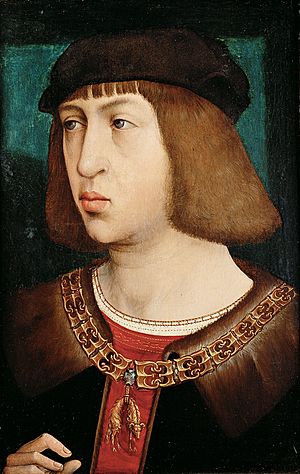
Portrait by Juan de Flandes, c. 1500
|
|
| King of Castile (jure uxoris) with Joanna |
|
| Reign | 12 July – 25 September 1506 |
| Proclamation | 12 July 1506 |
| Predecessor | Joanna |
| Successor | Joanna |
| Lord of the Netherlands Duke of Burgundy |
|
| Reign | 27 March 1482 – 25 September 1506 |
| Predecessor | Mary and Maximilian I |
| Successor | Charles II |
| Governors |
See list
|
| Regent | Maximilian I, Holy Roman Emperor (1482-1494) |
| Born | 22 July 1478 Bruges, Flanders, Burgundian Netherlands |
| Died | 25 September 1506 (aged 28) Burgos, Castile, Spain |
| Burial | Royal Chapel of Granada |
| Spouse | |
| Issue | |
| House | Habsburg |
| Father | Maximilian I, Holy Roman Emperor |
| Mother | Mary, Duchess of Burgundy |
| Religion | Roman Catholicism |
| Signature |  |
Philip the Handsome (born July 22, 1478 – died September 25, 1506) was a very important European ruler. He was also known as Philip the Fair because of his good looks. He ruled the Burgundian Netherlands from 1482 to 1506. For a short time in 1506, he was also the first Habsburg King of Castile (as Philip I).
Philip was the son of Maximilian I, Holy Roman Emperor and Mary of Burgundy. When his mother died in 1482, he became the ruler of the Burgundian lands. He was only four years old. Even at a young age, Philip was a good ruler. He worked for peace and helped the economy grow.
In 1496, Philip married Joanna. She was the daughter of Queen Isabella I of Castile and King Ferdinand II of Aragon. After her older siblings died, Joanna became the heir to the thrones of Castile and Aragon. This meant Philip would become king of a powerful Spanish kingdom.
Philip became King of Castile in 1506, but he died just a few months later. His wife, Joanna, was very sad. Her father, Ferdinand II, and her son, Charles V, Holy Roman Emperor, took control. Joanna was kept away from power for the rest of her life.
Philip was the first ruler from the Habsburg family in Spain. All Spanish kings and queens after his son, Charles V, were his descendants. Philip died before his father, so he never became Holy Roman Emperor. However, his son Charles united many lands. These included the Habsburg, Burgundian, Castilian, and Aragonese territories. Philip greatly expanded the Habsburg family's power. His family would rule large parts of Europe for the next 500 years.
Contents
Philip's Life Story
His Early Life and Family
Philip was born in Bruges on July 22, 1478. His parents were Maximilian I and Mary, Duchess of Burgundy. He was born in what is now Belgium. When Philip was born, some people spread rumors that he was a girl. To prove them wrong, his step-grandmother, Margaret of York, showed him to the public. He was named after his great-grandfather, Philip the Good.
Philip was only four years old when his mother died in 1482. He then became the ruler of the Burgundian lands. His father, Maximilian, became his guardian. This time was difficult, with some towns in Flanders wanting more freedom. Philip was even taken away by a council for a while. But by 1485, his father got him back. By 1492, all rebellions were stopped.
Even with these problems, Philip had a good childhood. He learned many skills like archery, tennis, and hunting. He was also a good dancer and loved music. His father, Maximilian, was often away fighting wars. Philip's main teachers were Olivier de la Marche and François de Busleyden.
Becoming a Ruler
In 1493, Philip's grandfather died, and his father, Maximilian, became the leader of the Holy Roman Empire. Maximilian decided to give control of the Burgundian lands to 15-year-old Philip. People in Burgundy were happy because Philip was born there and spoke their language. He was also known for wanting peace.
Philip officially took control in 1494. He brought back some of his great-grandfather's centralizing policies. This helped to make the government stronger. Philip was young and trusted his advisors, but he also had his own ideas. He wanted peace with France, which sometimes disagreed with his father.
Philip worked to keep peace and help the economy in his lands. He also set up the Great Council of Mechelen, which was the highest court. This helped to make the government more organized. People in the Low Countries loved him for his policies.
Philip also visited Germany several times. He went to important meetings called the Reichstag. There, he represented his father and met with other leaders.
Marriage and the Spanish Throne
Philip's marriage was part of a plan to make his family stronger against France. On October 20, 1496, he married Joanna in Belgium. She was the daughter of the King and Queen of Spain. Philip's sister, Margaret, also married Joanna's brother, John.
At first, Joanna was not expected to become queen. But her brother John died in 1497. Then, her older sister Isabella died in 1498, and Isabella's baby son also died in 1500. This meant that Joanna became the next in line to the thrones of Castile and Aragon.
In 1502, Philip and Joanna traveled to Spain. They were recognized as the future rulers. Philip returned to the Low Countries the next year, leaving Joanna behind. She gave birth to their son, Ferdinand, in Spain.
Joanna loved Philip very much, but their marriage was difficult. Philip often tried to take control of her power. This led to rumors about her mental health. Many historians now believe she was just very sad or depressed, not truly insane.
King of Castile
In 1504, Joanna's mother, Queen Isabella of Castile, died. Joanna became the Queen of Castile. Her father, King Ferdinand II, wanted to rule Castile for her. But the nobles did not like him, so they asked Philip to come to Spain. Philip was then recognized as king.
On their way to Spain in 1506, Philip and Joanna's ship was caught in a storm. They landed in England. They stayed with King Henry VII for six weeks. Philip had to sign a treaty with Henry VII to be allowed to leave. This treaty helped trade and included an agreement to send back rebels.
Philip and Joanna arrived in Spain on April 28, 1506. Philip and Joanna's father, Ferdinand, met to discuss who would rule Castile. They agreed that Joanna was not able to rule. It suited both Philip and Ferdinand to say this.
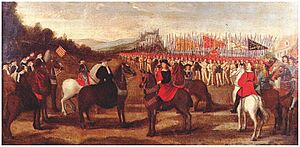
On June 27, 1506, Philip and Ferdinand signed the Treaty of Villafáfila. Philip was officially named King of Castile. Ferdinand secretly said he didn't agree with the treaty, but he left for Aragon. Philip then started to appoint his own people to important positions in Castile.
Philip also worked to improve the postal system. He made an agreement with the Taxis family to run it. This helped communication between Germany, the Netherlands, France, and Spain.
Supporting the Arts
Philip was a big supporter of artists, especially the painter Hieronymus Bosch. In 1504, he asked Bosch to paint a large artwork.
Philip also had some of the best musicians in Europe in his royal chapel. These included famous composers like Pierre de La Rue and Alexander Agricola. He loved instrumental music. Philip also preferred handwritten books, especially music books, which he used as gifts to other leaders.
He supported the famous scholar Desiderius Erasmus. Erasmus praised Philip for making peace with France.
His Death and What Happened Next
Philip died suddenly in Burgos on September 25, 1506. He seemed to have died from typhoid fever. However, some people at the time, including his wife, believed he was poisoned. His wife was so sad that she reportedly did not want his body to be buried for a while. Philip is buried in the Royal Chapel of Granada in Spain.
After Philip's death, his father, Maximilian, appointed Philip's sister, Margaret, to govern the Netherlands. In Spain, some people tried to change the Inquisition after Philip died. But Ferdinand, Joanna's father, later took control and made sure the Inquisition continued.
Why He Was Called "the Handsome"
Many people at the time noticed Philip's good looks. The Venetian ambassador described him as "physically beautiful, vigorous and rich." Even King Louis XII of France said, "What a handsome prince!"
Philip was a slim and athletic person. He enjoyed sports and hunting. He also liked to dress in fancy clothes. His skills in knightly exercises were so good that he even taught other princes.
Philip's Legacy
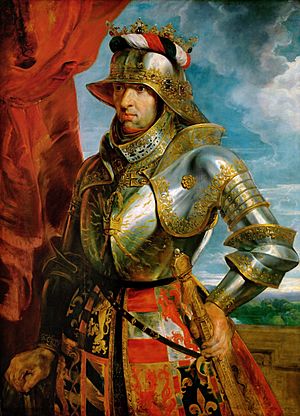
Philip is sometimes overshadowed by his famous parents and his son, Charles V. He died young, so he didn't have as much time to show his full potential. He was not yet aiming to rule a huge empire like his son Charles did.
However, Philip was important because he continued the work of the Dukes of Burgundy. He helped to build a stronger government in the Low Countries. He was known as a prince who brought peace and agreement. His education and his royal court showed the best of Burgundian culture.
Historians agree that Philip was a good prince who cared about the Low Countries. He and his sister Margaret helped their father's plans for expanding the Habsburg family's power. This paved the way for the Habsburgs to become very successful rulers in Europe.
Artistic Depictions
Philip has been shown in various artworks:
- A composer named Peter Frey wrote a song about Philip's journey in 1506.
- There are two old songs from the Netherlands about Philip's journey and death. One of them even says his wife poisoned him, but this is not proven.
- A sad song called Absalon, fili mi might have been written to remember Philip after he died.
- A large artwork called Arch of Philip IV by Peter Paul Rubens shows Philip and Joanna's marriage.
- There is a large statue of Philip at Maximilian's tomb in Innsbruck.
- Many paintings show the scene of Philip's death and Joanna mourning him. A famous one is Doña Joanna the Mad (1877) by Francisco Pradilla.
Philip's Family
Philip and Joanna of Castile had six children. At the start of their marriage, Philip truly loved Joanna. However, he believed that only men should rule. He couldn't accept that Joanna wanted to have her own political power. This caused problems in their marriage. Philip's controlling actions, along with Ferdinand's ambitions and Joanna's sadness, made their marriage difficult.
Their children were:
- Eleanor (1498–1558), who became queen of Portugal and France.
- Charles V (1500–1558), who became King of Spain and Holy Roman Emperor.
- Isabella (1501–1526), who became queen of Denmark, Norway, and Sweden.
- Ferdinand (1503-1564), who became Holy Roman Emperor.
- Mary (1505–1558), who became queen of Hungary and governor of the Spanish Netherlands.
- Catherine (1507–1578), who became queen of Portugal.
Philip's Titles
Philip held many important titles during his life:
 From 1482 to 1506: Titular Duke of Burgundy (as Philip IV)
From 1482 to 1506: Titular Duke of Burgundy (as Philip IV) From 1482 to 1506: Duke of Brabant (as Philip III)
From 1482 to 1506: Duke of Brabant (as Philip III) From 1482 to 1506: Duke of Limburg (as Philip III)
From 1482 to 1506: Duke of Limburg (as Philip III) From 1482 to 1506: Duke of Lothier (as Philip III)
From 1482 to 1506: Duke of Lothier (as Philip III) From 1482 to 1506: Duke of Luxemburg (as Philip II)
From 1482 to 1506: Duke of Luxemburg (as Philip II) From 1482 to 1506: Margrave of Namur (as Philip V)
From 1482 to 1506: Margrave of Namur (as Philip V) From 1482 to 1506: Count Palatine of Burgundy (as Philip VI)
From 1482 to 1506: Count Palatine of Burgundy (as Philip VI) From 1482 to 1506: Count of Artois (as Philip VI)
From 1482 to 1506: Count of Artois (as Philip VI) From 1482 to 1506: Count of Charolais (as Philip III)
From 1482 to 1506: Count of Charolais (as Philip III) From 1482 to 1506: Count of Flanders (as Philip IV)
From 1482 to 1506: Count of Flanders (as Philip IV) From 1482 to 1506: Count of Hainaut (as Philip II)
From 1482 to 1506: Count of Hainaut (as Philip II) From 1482 to 1506: Count of Holland (as Philip II)
From 1482 to 1506: Count of Holland (as Philip II)From 1482 to 1506: Count of Zeeland (as Philip II)
 From 1482 to 1492: Duke of Guelders (as Philip I)
From 1482 to 1492: Duke of Guelders (as Philip I) From 1482 to 1492: Count of Zutphen (as Philip I)
From 1482 to 1492: Count of Zutphen (as Philip I) From 1504 to 1506: King of Castile (as Philip I) because of his marriage to Joanna.
From 1504 to 1506: King of Castile (as Philip I) because of his marriage to Joanna.
See also
 In Spanish: Felipe I de Castilla para niños
In Spanish: Felipe I de Castilla para niños


